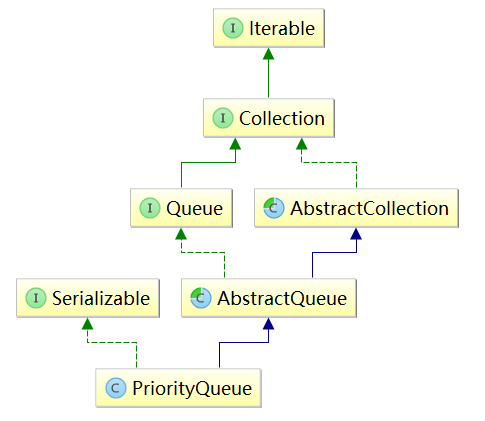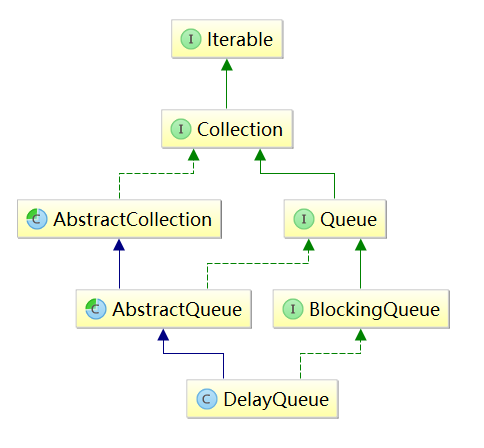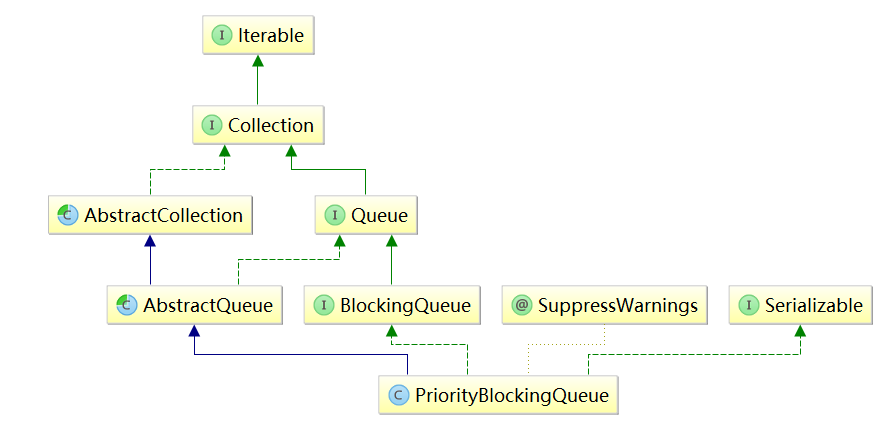一、DelayQueue并发容器
1.Delay
Queue的底层实现
Delay
Queue是一个线程安全且无界的阻塞队列,只有在延迟时间满足后才能获取队列中的元素,因此队列中的元素必须实现Delay接口,在创建元素时指定多久时间后才能从队列中获取该元素。Delay
Queue的底层实现是使用了PriorityQueue+ReentrantLock来实现延迟获取功能。
2.PriorityQueue分析
其中PriorityQueue是种优先级队列,线程不安全,队列中的元素会按照优先级来排序。该队列底层实现是使用二叉堆,并且元素按照其自然顺序进行排序,或者根据构造队列时提供的Comparator进行排序。因为PriorityQueue中的元素都要进行比较,所以优先级队列中不能拥有null元素,也不能有不能比较的元素。
PriorityQueue的继承关系如下图:

PriorityQueue中的属性及构造方法:
public class PriorityQueue<E> extends AbstractQueue<E>
implements java.io.Serializable {
//队列的默认容量
private static final int DEFAULT_INITIAL_CAPACITY = 11;
//底层用于存放数据的数组
transient Object[] queue; // non-private to simplify nested class access
//队列中的元素数量计数
private int size = 0;
//比较器
private final Comparator<? super E> comparator;
//快速失败机制使用的变量
transient int modCount = 0;
//创建一个默认容量的队列
public PriorityQueue() {
this(DEFAULT_INITIAL_CAPACITY, null);
}
//创建一个指定容量的队列
public PriorityQueue(int initialCapacity) {
this(initialCapacity, null);
}
//创建一个指定比较器的默认容量队列
public PriorityQueue(Comparator<? super E> comparator) {
this(DEFAULT_INITIAL_CAPACITY, comparator);
}
//创建一个指定比较器且指定容量队列
public PriorityQueue(int initialCapacity,
Comparator<? super E> comparator) {
//判断指定的容量值是否合法
if (initialCapacity < 1)
throw new IllegalArgumentException();
this.queue = new Object[initialCapacity]; //初始化底层数组
this.comparator = comparator; //比较器初始化
}
//创建一个带有指定集合中的元素的队列
@SuppressWarnings("unchecked")
public PriorityQueue(Collection<? extends E> c) {
//判断c是否是有序集合
//若是有序集合,那么就以其比较器作为队列的比较器
if (c instanceof SortedSet<?>) {
SortedSet<? extends E> ss = (SortedSet<? extends E>) c;
this.comparator = (Comparator<? super E>) ss.comparator();
initElementsFromCollection(ss);
}
//判断集合是否是优先级队列
//若是的话,直接使用该队列的比较器,
else if (c instanceof PriorityQueue<?>) {
PriorityQueue<? extends E> pq = (PriorityQueue<? extends E>) c;
this.comparator = (Comparator<? super E>) pq.comparator();
initFromPriorityQueue(pq);
}
else {
this.comparator = null;
initFromCollection(c);
}
}
//将容器c中的元素添加到优先级队列中
private void initElementsFromCollection(Collection<? extends E> c) {
Object[] a = c.toArray();
// If c.toArray incorrectly doesn't return Object[], copy it.
if (a.getClass() != Object[].class)
a = Arrays.copyOf(a, a.length, Object[].class);
int len = a.length;
if (len == 1 || this.comparator != null)
for (int i = 0; i < len; i++)
if (a[i] == null)
throw new NullPointerException();
this.queue = a;
this.size = a.length;
}
//将优先级队列c中的元素添加到当前优先级队列中
private void initFromPriorityQueue(PriorityQueue<? extends E> c) {
if (c.getClass() == PriorityQueue.class) {
this.queue = c.toArray();
this.size = c.size();
} else {
initFromCollection(c);
}
}
//将容器c中的元素添加到优先级队列中
private void initFromCollection(Collection<? extends E> c) {
initElementsFromCollection(c);
heapify();
}
//创建包含优先级队列c中元素的队列,且使用同一个比较器
@SuppressWarnings("unchecked")
public PriorityQueue(PriorityQueue<? extends E> c) {
this.comparator = (Comparator<? super E>) c.comparator();
initFromPriorityQueue(c);
}
//创建包含排序集合c中元素的优先级队列,且使用同一个比较器
@SuppressWarnings("unchecked")
public PriorityQueue(SortedSet<? extends E> c) {
this.comparator = (Comparator<? super E>) c.comparator();
initElementsFromCollection(c);
}
}PriorityQueue中的入队方法分析:
//add与offer没有区别
public boolean add(E e) {
return offer(e);
}
public boolean offer(E e) {
//队列中不允许有null元素
if (e == null)
throw new NullPointerException();
modCount++; //快速失败机制
int i = size; //获取当前队列中元素个数
//判断数组是否需要扩容
if (i >= queue.length)
grow(i + 1);
size = i + 1; //元素计数+1
//新增元素的插入位置
//若队列原本为空,则直接放到0位置
//若队列原本不为空
if (i == 0)
queue[0] = e;
else
siftUp(i, e); //插入数组
return true;
}
//扩容
private void grow(int minCapacity) {
int oldCapacity = queue.length; //队列旧容量
//扩容机制,队列原容量小于64时,扩容为原来的2倍再加2
//大于64,则扩大1.5倍
int newCapacity = oldCapacity + ((oldCapacity < 64) ?
(oldCapacity + 2) :
(oldCapacity >> 1));
if (newCapacity - MAX_ARRAY_SIZE > 0)
newCapacity = hugeCapacity(minCapacity);
queue = Arrays.copyOf(queue, newCapacity);
}
//上浮
/**
* 上浮过程
* 假设已有一个有序堆(升序)如下所示:
* 10
* / \
* 20 40
* / \ /
* 60 70 90
* 现在要将元素30插入堆中,则有
* 1.将要插入的30先放在二叉堆的末尾
* 2.再将其与父结点进行比较,判断是否要上浮(小于父结点就上浮)
* 3.若小于父结点则交换位置,再重复第2步骤继续上浮
* 4.若大于则直接结束上浮
* 10 10
* / \ / \
* 20 40 ——> 20 30
* / \ / \ / \ / \
* 60 70 90 30 60 70 90 40
*/
private void siftUp(int k, E x) {
//判断队列是自然排序还是比较器排序
if (comparator != null)
siftUpUsingComparator(k, x); //比较器排序
else
siftUpComparable(k, x); //自然排序
}
//入队操作本质是一个堆排序中的一个上浮的过程
private void siftUpUsingComparator(int k, E x) {
//判断索引位置是否大于0,即是否到达堆顶
while (k > 0) {
int parent = (k - 1) >>> 1;
Object e = queue[parent];
if (comparator.compare(x, (E) e) >= 0)
break;
queue[k] = e;
k = parent;
}
queue[k] = x;
}
//另一个上浮方法,使用的自然排序
private void siftUpComparable(int k, E x) {
Comparable<? super E> key = (Comparable<? super E>) x;
while (k > 0) {
int parent = (k - 1) >>> 1;
Object e = queue[parent];
if (key.compareTo((E) e) >= 0)
break;
queue[k] = e;
k = parent;
}
queue[k] = key;
}PriorityQueue中的出队方法分析:
public E poll() {
if (size == 0) //判断队列是否是空队列
return null;
int s = --size;
modCount++;
E result = (E) queue[0]; //取出队首元素
E x = (E) queue[s]; //获取队尾元素
queue[s] = null; //队尾赋null
//将原本的队尾元素放到堆顶,再对整个堆进行排序整理
//即下沉
if (s != 0)
siftDown(0, x); //下沉方法
return result;
}
//下沉
/**
* 下沉过程
* 假设已有一个有序堆(升序)如下所示:
* 10
* / \
* 20 30
* / \ / \
* 60 70 90 40
* 现在要将元素10出队,则有
* 1.将要出队的10移除出二叉堆,并将队尾40放到堆顶
* 2.将堆顶元素与两个子结点中较小的元素相比较,选择小的元素作为新的堆顶元素
* 3.重复对堆中前一半结点进行将第2步的比较交换
* 40 20
* / \ / \
* 20 30 ——> 40 30
* / \ / / \ /
* 60 70 90 60 70 90
*/
private void siftDown(int k, E x) {
if (comparator != null)
siftDownUsingComparator(k, x); //比较器下沉
else
siftDownComparable(k, x); //自然排序下沉
}
//使用自然排序下沉
private void siftDownComparable(int k, E x) {
Comparable<? super E> key = (Comparable<? super E>)x;
int half = size >>> 1; //下沉要对堆中前一半的结点都进行
while (k < half) {
int child = (k << 1) + 1;
Object c = queue[child]; //获取当前结点的左孩子
int right = child + 1; //右孩子索引
//若存在右孩子,那么左右孩子先比较大小,取小再与父结点比较
if (right < size &&
((Comparable<? super E>) c).compareTo((E) queue[right]) > 0)
c = queue[child = right];
//父结点与子结点比较
//若父结点小于子结点,则直接结束下沉的过程
//否则,交互位置后继续下沉操作
if (key.compareTo((E) c) <= 0)
break;
queue[k] = c;
k = child;
}
queue[k] = key;
}
//使用比较器下沉
@SuppressWarnings("unchecked")
private void siftDownUsingComparator(int k, E x) {
int half = size >>> 1;
while (k < half) {
int child = (k << 1) + 1;
Object c = queue[child];
int right = child + 1;
if (right < size && comparator.compare((E) c, (E) queue[right]) > 0)
c = queue[child = right];
if (comparator.compare(x, (E) c) <= 0)
break;
queue[k] = c;
k = child;
}
queue[k] = x;
}3.DelayQueue的继续体系
了解了DelayQueue的底层实际是通过PriorityQueue实现,再来看看DelayQueue的继承关系,如下图所示,父类及接口之前的学习中都已分析过,不在赘言。

4.Delay接口
DelayQueue队列与其他队列最明显的不同之处,就是它的延时功能,也正因为这个延时特点,DelayQueue中的对象都必须要实现Delay接口,接下来就看看这个Delay接口是干什么的。
//用来标记那些应该在给定延迟时间之后执行的对象
public interface Delayed extends Comparable<Delayed> {
//检查延迟是否结束,该方法返回一个延迟时间,时间到后在检查还有没有
//延迟,若没有延迟执行下一步,若还有延迟,继续等待
long getDelay(TimeUnit unit);
}DelayQueue的使用示例:
/**
* 延迟队列的使用示例
* 主线程创建三个延迟任务放到queue中,其他三个线程
* 在任务可用时取出
* Created by bzhang on 2019/4/1.
*/
public class TestDelayed implements Delayed {
private String name;
private Date takeTime; //延迟时间
public TestDelayed(String name, Date takeTime) {
this.name = name;
this.takeTime = takeTime;
}
public String getName() {
return name;
}
public void setName(String name) {
this.name = name;
}
public Date getTakeTime() {
return takeTime;
}
public void setTakeTime(Date takeTime) {
this.takeTime = takeTime;
}
@Override
public long getDelay(TimeUnit unit) {
long convert = unit.convert(takeTime.getTime()-System.currentTimeMillis(), TimeUnit.MILLISECONDS);
return convert;
}
@Override
public int compareTo(Delayed o) {
TestDelayed t = (TestDelayed)o;
long l = this.takeTime.getTime() - t.getTakeTime().getTime();
if (l==0){
return 0;
}
return l > 0 ? 1 : -1;
}
@Override
public String toString() {
return "TestDelayed{" +
"name='" + name + '\'' +
", takeTime=" + takeTime +
'}';
}
public static void main(String[] args) {
DelayQueue queue = new DelayQueue();
long l = System.currentTimeMillis();
queue.put(new TestDelayed("A",new Date(l+5000)));
queue.put(new TestDelayed("B",new Date(l+2000)));
queue.put(new TestDelayed("C",new Date(l+7000)));
System.out.println(new Date());
int t = 0;
for (int i = 0;i < 3;i++){
new Thread(new Runnable() {
@Override
public void run() {
try {
System.out.println(Thread.currentThread().getName()+queue.take());
} catch (InterruptedException e) {
e.printStackTrace();
}
}
}).start();
}
}
}
//结果
Tue Apr 02 11:03:33 CST 2019
Thread-1TestDelayed{name='B', takeTime=Tue Apr 02 11:03:35 CST 2019}
Thread-0TestDelayed{name='A', takeTime=Tue Apr 02 11:03:38 CST 2019}
Thread-2TestDelayed{name='C', takeTime=Tue Apr 02 11:03:40 CST 2019}5.DelayQueue中的重要属性及构造方法
public class DelayQueue<E extends Delayed> extends AbstractQueue<E>
implements BlockingQueue<E> {
//重入锁,用于保证并发安全
private final transient ReentrantLock lock = new ReentrantLock();
//底层优先级队列,实际元素都存储与该队列中,底层是数组构成的二叉堆
private final PriorityQueue<E> q = new PriorityQueue<E>();
//下一个等待获取元素的线程,可减少不必要的等待
private Thread leader = null;
//条件控制,表示是否可以从队列中取数据
private final Condition available = lock.newCondition();
public DelayQueue() {}
public DelayQueue(Collection<? extends E> c) {
this.addAll(c);
}
}6.DelayQueue的入队方法
//add方法本质就是调用offer方法,将元素新增到队列
public boolean add(E e) {
return offer(e);
}
//同上
public void put(E e) {
offer(e);
}
//延迟队列是无界队列,指定超时时间放入元素没有意义,与直接入队是一样的
public boolean offer(E e, long timeout, TimeUnit unit) {
return offer(e);
}
//向队列中新增元素,元素位置以比较结果(compareTo方法)来确定
public boolean offer(E e) {
final ReentrantLock lock = this.lock;
lock.lock();
try {
q.offer(e); //调用底层优先级队列的offer方法来存储元素
//判断底层优先级队列的队首是否是新增元素
if (q.peek() == e) {
leader = null;
//唤醒条件等待队列的某一个线程,即说明队列中有元素了,
//可以从队列中获取到元素了
available.signal();
}
return true;
} finally {
lock.unlock();
}
}7.DelayQueue的出队方法
//返回延迟时间已到的第一个元素,或返回null(没有元素或元素延迟时间都未到)
public E poll() {
final ReentrantLock lock = this.lock; //重入锁
lock.lock(); //加锁同步
try {
E first = q.peek(); //获取优先级队列中的队首元素
//判断队列是否为空,若不为空那么队首延迟时间是否到达,若都不满足
//说明队首元素可用,返回队首
//否则返回null
if (first == null || first.getDelay(NANOSECONDS) > 0)
return null;
else
return q.poll();
} finally {
lock.unlock();
}
}
//若有延迟时间已到的元素就立即返回,若无则一直等待
//队列中无元素那么也一直等待
public E take() throws InterruptedException {
final ReentrantLock lock = this.lock;
lock.lockInterruptibly(); //可被中断锁
try {
for (;;) { //自旋
E first = q.peek(); //获取队首元素
//若队列为空,直接进入条件队列等待唤醒
//队列不为空,则判断队首的延时是否到达
if (first == null)
available.await();
else {
long delay = first.getDelay(NANOSECONDS); //获取剩余延迟时间(单位是ns)
if (delay <= 0) //没有剩余延迟时间,则将队首元素返回
return q.poll();
first = null;
//判断是否已经有其他线程在等待取元素
//若有,那么就让当前线程直接等待
//若没有,那就说明当前只有本线程在等待获取队首元素
if (leader != null)
available.await();
else {
Thread thisThread = Thread.currentThread(); //获取当前线程
leader = thisThread; //将单签线程设为等待获取队首的线程
try {
//等待队首元素的延迟时间后,在尝试获取队首元素
available.awaitNanos(delay);
} finally {
//将等待获取的线程设为null,因为当前线程正在获取,因此不应该有leader
//即leader为null,说明要么有线程正在执行获取操作,要么没有出队操作在进行
if (leader == thisThread)
leader = null;
}
}
}
}
} finally {
//当前线程已经取完元素了,可以唤醒其他线程获取队首元素了
if (leader == null && q.peek() != null)
available.signal();
lock.unlock();
}
}
//指定时间内获取延迟的队首元素,若在指定等待时间内队首延迟时间未到达或队列为空
//就返回null
public E poll(long timeout, TimeUnit unit) throws InterruptedException {
long nanos = unit.toNanos(timeout);
final ReentrantLock lock = this.lock;
lock.lockInterruptibly();
try {
for (;;) {
E first = q.peek();
//队列是否为空,若为空队列,那么在指定等待是否到达,若等待时间也已到达
//那就返回null,若未到达等待时间,就继续等待
if (first == null) {
if (nanos <= 0)
return null;
else
nanos = available.awaitNanos(nanos); //当前线程进入等待时间nanos纳秒
} else {
long delay = first.getDelay(NANOSECONDS); //获取队首元素的延迟时间
//判断延迟时间是否到达,到达就直接将队首元素返回
if (delay <= 0)
return q.poll();
//延迟时间未到,但等待时间已经达到,那么就返回null
if (nanos <= 0)
return null;
first = null; // don't retain ref while waiting
//延迟时间小于等待时间,说明可以在等待时间内获取到队首元素
//那么就在等待延迟时间到达的时间内,可以再次尝试将队首元素获取返回
//这里仅是再次尝试,因为可能在等待期间内有新的元素入队,且延迟时间最小成为新队首
if (nanos < delay || leader != null)
nanos = available.awaitNanos(nanos);
else {
//等待时间 > 延迟时间 并且没有其它线程在等待,
//那么当前元素成为leader,表示当前线程最早正在等待获取元素
Thread thisThread = Thread.currentThread();
leader = thisThread;
try {
//让等待时间到达
long timeLeft = available.awaitNanos(delay);
//继续等待的时间
nanos -= delay - timeLeft;
} finally {
if (leader == thisThread)
leader = null;
}
}
}
}
} finally {
if (leader == null && q.peek() != null)
available.signal();
lock.unlock();
}
}8.peek方法
//peek方法仅仅就是为底层的优先级队列的peek方法加上锁
public E peek() {
final ReentrantLock lock = this.lock;
lock.lock();
try {
return q.peek();
} finally {
lock.unlock();
}
}二、PriorityBlockingQueue并发容器
1.PriorityBlockingQueue的底层实现
PriorityBlockingQueue是一个线程安全的无界阻塞队列,可以看对是PriorityQueue的多线程版本,其底层数据结构与PriorityQueue相同,都是数组实现的利用二叉堆结构。前文已经分析过,这里不再多说
2.PriorityBlockingQueue的继承体系
PriorityBlockingQueue的继承关系如下图所示,均是之前学习过的父类或接口。这里不再展开。

3.PriorityBlockingQueue中的重要属性及构造方法
public class PriorityBlockingQueue<E> extends AbstractQueue<E>
implements BlockingQueue<E>, java.io.Serializable {
//未指定队列初始容量时使用的默认容量
private static final int DEFAULT_INITIAL_CAPACITY = 11;
//队列虽然说是无界的,但实际队列是不能超过Integer.MAX_VALUE - 8这个值的
//若是超过报OOM异常
private static final int MAX_ARRAY_SIZE = Integer.MAX_VALUE - 8;
//底层存放数据的数组
private transient Object[] queue;
//队列中元素的个数,计数器
private transient int size;
//用于判断优先级的比较器,若为null则使用自然排序
private transient Comparator<? super E> comparator;
//重入锁,保证并发安全
private final ReentrantLock lock;
//队列非空条件,用于出队操作
private final Condition notEmpty;
//用于队列显示是否处于扩容状态,0表示没有在扩容
//而1表示处于扩容状态,将该值更新成1的线程会进行数组扩容
//其他要进行扩容的线程检查该值发现为1,则直接暂停线程让出CPU
private transient volatile int allocationSpinLock;
//将队列转换成线程不安全的优先级队列,用于序列化
private PriorityQueue<E> q;
//创建一个默认初始容量的队列
public PriorityBlockingQueue() {
this(DEFAULT_INITIAL_CAPACITY, null);
}
//创建一个指定初始容量的队列
public PriorityBlockingQueue(int initialCapacity) {
this(initialCapacity, null);
}
//创建一个指定容量和比较器的队列
public PriorityBlockingQueue(int initialCapacity,
Comparator<? super E> comparator) {
if (initialCapacity < 1)
throw new IllegalArgumentException();
this.lock = new ReentrantLock();
this.notEmpty = lock.newCondition();
this.comparator = comparator;
this.queue = new Object[initialCapacity];
}
//以集合c为底,创建一个队列
public PriorityBlockingQueue(Collection<? extends E> c) {
this.lock = new ReentrantLock();
this.notEmpty = lock.newCondition();
boolean heapify = true; // true if not known to be in heap order
boolean screen = true; // true if must screen for nulls
//根据集合c是哪一种容器来决定创建怎样的初始队列
if (c instanceof SortedSet<?>) {
SortedSet<? extends E> ss = (SortedSet<? extends E>) c;
this.comparator = (Comparator<? super E>) ss.comparator();
heapify = false;
}
else if (c instanceof PriorityBlockingQueue<?>) {
PriorityBlockingQueue<? extends E> pq =
(PriorityBlockingQueue<? extends E>) c;
this.comparator = (Comparator<? super E>) pq.comparator();
screen = false;
if (pq.getClass() == PriorityBlockingQueue.class) // exact match
heapify = false;
}
Object[] a = c.toArray();
int n = a.length;
// If c.toArray incorrectly doesn't return Object[], copy it.
if (a.getClass() != Object[].class)
a = Arrays.copyOf(a, n, Object[].class);
if (screen && (n == 1 || this.comparator != null)) {
for (int i = 0; i < n; ++i)
if (a[i] == null)
throw new NullPointerException();
}
this.queue = a;
this.size = n;
if (heapify)
heapify();
}
}4.入队方法
//PriorityBlockingQueue所有的入队方法,都一样,因为队列是无界队列
//不存在加入队列失败的可能,因此最终都是调用offer方法
public boolean add(E e) {
return offer(e);
}
public void put(E e) {
offer(e); // never need to block
}
public boolean offer(E e, long timeout, TimeUnit unit) {
return offer(e); // never need to block
}
public boolean offer(E e) {
//优先级队列中不允许存在null元素,因此null元素无法确定优先级
if (e == null)
throw new NullPointerException();
final ReentrantLock lock = this.lock;
lock.lock();
int n, cap; //n为当前队列中的元素个数,cap为当前队列的容量
Object[] array;
//判断底层数组是否需要扩容
while ((n = size) >= (cap = (array = queue).length))
tryGrow(array, cap);
try {
Comparator<? super E> cmp = comparator;
//判断是使用比较器进行上浮操作,还是使用自然排序进行上浮操作
if (cmp == null)
siftUpComparable(n, e, array); //自然排序上浮
else
siftUpUsingComparator(n, e, array, cmp); //比较器上浮
size = n + 1;
notEmpty.signal();
} finally {
lock.unlock();
}
return true;
}
//自然上浮,与PriorityQueue中一样
private static <T> void siftUpComparable(int k, T x, Object[] array) {
Comparable<? super T> key = (Comparable<? super T>) x;
while (k > 0) {
int parent = (k - 1) >>> 1; //获取父结点索引
Object e = array[parent]; //父结点
//比较插入的值与父结点的大小,若比父结点小,那么交换位置后,在继续比较
//若比父结点大,说明排序正确,无需在继续比较
if (key.compareTo((T) e) >= 0)
break;
array[k] = e;
k = parent;
}
array[k] = key;
}
//比较器比较上浮
private static <T> void siftUpUsingComparator(int k, T x, Object[] array,
Comparator<? super T> cmp) {
while (k > 0) {
int parent = (k - 1) >>> 1;
Object e = array[parent];
if (cmp.compare(x, (T) e) >= 0)
break;
array[k] = e;
k = parent;
}
array[k] = x;
}
//数组扩容
private void tryGrow(Object[] array, int oldCap) {
// 扩容时不需要加锁,因为扩容是通过CAS方式来实现的,
//这样不仅可以提升效率,并且不影响出队操作
lock.unlock();
Object[] newArray = null;
//将allocationSpinLock更新成1的线程进行数组扩容操作,其余要扩容的线程暂停
if (allocationSpinLock == 0 &&
UNSAFE.compareAndSwapInt(this, allocationSpinLockOffset,
0, 1)) {
try {
//扩容规则,容量小于64,扩大2倍+2,容量不小于64,则扩大1.5倍
int newCap = oldCap + ((oldCap < 64) ?
(oldCap + 2) : // grow faster if small
(oldCap >> 1));
//判断扩大后的容量是否越界
//若是会越界,则扩容规则改为旧容量+1,若仍越界,报OOM异常
if (newCap - MAX_ARRAY_SIZE > 0) { // possible overflow
int minCap = oldCap + 1;
if (minCap < 0 || minCap > MAX_ARRAY_SIZE)
throw new OutOfMemoryError();
newCap = MAX_ARRAY_SIZE;
}
if (newCap > oldCap && queue == array)
newArray = new Object[newCap]; //创建新数组
} finally {
allocationSpinLock = 0; //恢复为0,表示没有在扩容状态
}
}
if (newArray == null) //未竞争到扩容操作的线程暂停
Thread.yield();
lock.lock(); /重新上锁
if (newArray != null && queue == array) {
queue = newArray;
//将旧数组中的数据转移到新数组中
System.arraycopy(array, 0, newArray, 0, oldCap);
}
}5.出队方法
//获取并移除队首元素,若队列为空,返回null
public E poll() {
final ReentrantLock lock = this.lock;
lock.lock();
try {
return dequeue(); //真正出队的方法
} finally {
lock.unlock();
}
}
//真正执行获取并移除队首元素的方法
private E dequeue() {
int n = size - 1; //移除队首后队列中的元素个数 ,同时也是队尾元素的索引
//判断队列是否为空队列,空队列直接返回null
if (n < 0)
return null;
else {
Object[] array = queue; //获取底层数组引用
E result = (E) array[0]; //获取队首元素
E x = (E) array[n]; //获取队尾元素
array[n] = null; //队尾置为null
Comparator<? super E> cmp = comparator;
//将原来队列的队尾放到队首位置,然后进行下沉操作(即二叉堆重新排序的操作)
if (cmp == null)
siftDownComparable(0, x, array, n); //使用自然排序下沉
else
siftDownUsingComparator(0, x, array, n, cmp); //使用比较器下沉
size = n;
return result;
}
}
//下沉操作与PriorityQueue中相同,这里不在多做分析
//自然排序下沉
private static <T> void siftDownComparable(int k, T x, Object[] array,
int n) {
if (n > 0) {
Comparable<? super T> key = (Comparable<? super T>)x;
int half = n >>> 1; // loop while a non-leaf
while (k < half) {
int child = (k << 1) + 1; // assume left child is least
Object c = array[child];
int right = child + 1;
if (right < n &&
((Comparable<? super T>) c).compareTo((T) array[right]) > 0)
c = array[child = right];
if (key.compareTo((T) c) <= 0)
break;
array[k] = c;
k = child;
}
array[k] = key;
}
}
//比较器下沉
private static <T> void siftDownUsingComparator(int k, T x, Object[] array,
int n,
Comparator<? super T> cmp) {
if (n > 0) {
int half = n >>> 1;
while (k < half) {
int child = (k << 1) + 1;
Object c = array[child];
int right = child + 1;
if (right < n && cmp.compare((T) c, (T) array[right]) > 0)
c = array[child = right];
if (cmp.compare(x, (T) c) <= 0)
break;
array[k] = c;
k = child;
}
array[k] = x;
}
}
//获取并移除队首元素,若队列已空,则等待
public E take() throws InterruptedException {
final ReentrantLock lock = this.lock;
lock.lockInterruptibly();
E result;
try {
//若返回的元素为null,说明队列中没有元素
//那么让当前线程进入条件队列中等待,当前队列有元素时,则
//会唤醒线程,在尝试获取并移除队首
while ( (result = dequeue()) == null)
notEmpty.await();
} finally {
lock.unlock();
}
return result;
}
//在一定时间内尝试获取并移除队首元素,若在指定时间内未成功,
//返回null
public E poll(long timeout, TimeUnit unit) throws InterruptedException {
long nanos = unit.toNanos(timeout);
final ReentrantLock lock = this.lock;
lock.lockInterruptibly();
E result;
try {
//尝试获取并移除队首,若失败但超时时间未到,则进入条件等待
//一段时间后在进行尝试,若超时时间已过仍为成功获取并移除队首
//则返回null
while ( (result = dequeue()) == null && nanos > 0)
nanos = notEmpty.awaitNanos(nanos);
} finally {
lock.unlock();
}
return result;
}
//获取但不移除队首元素
public E peek() {
final ReentrantLock lock = this.lock;
lock.lock();
try {
return (size == 0) ? null : (E) queue[0];
} finally {
lock.unlock();
}
}
6.总结
1.PriorityBlocking
Queue是基于数组实现的二叉堆结构。
2.PriorityBlocking
Queue中涉及到元素之间的比较,因此不能存在null元素。
3.PriorityBlocking
Queue的入队出队操作线程安全是通过重入锁ReentrantLock实现的,但在扩容时是基于CAS算法实现的。
4.PriorityBlocking
Queue是无界队列,其入队出队规则是基于优先级的,虽然说是无界队列,但并不是无限大的,容量不能超过
Integer.MAX_VALUE - 8。
来源:oschina
链接:https://my.oschina.net/u/4085994/blog/3044798